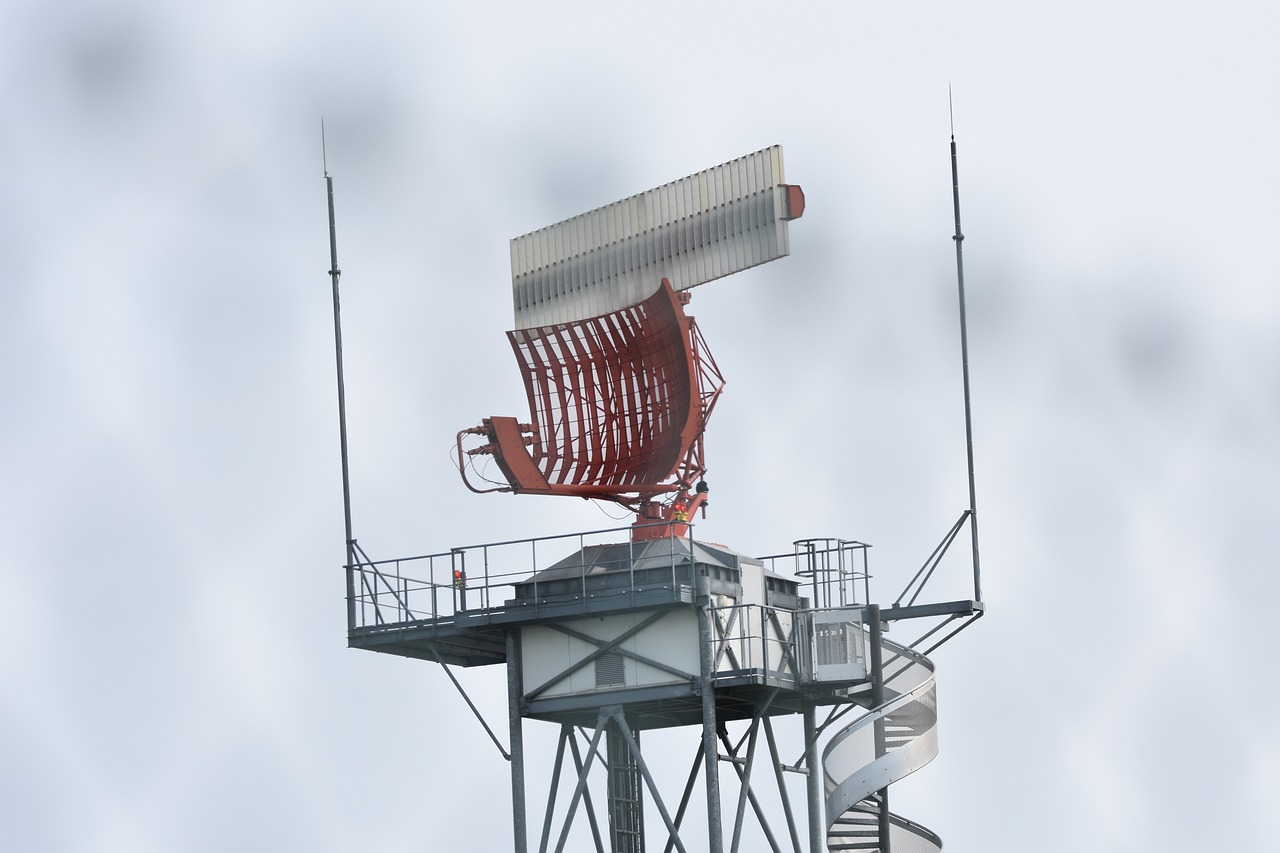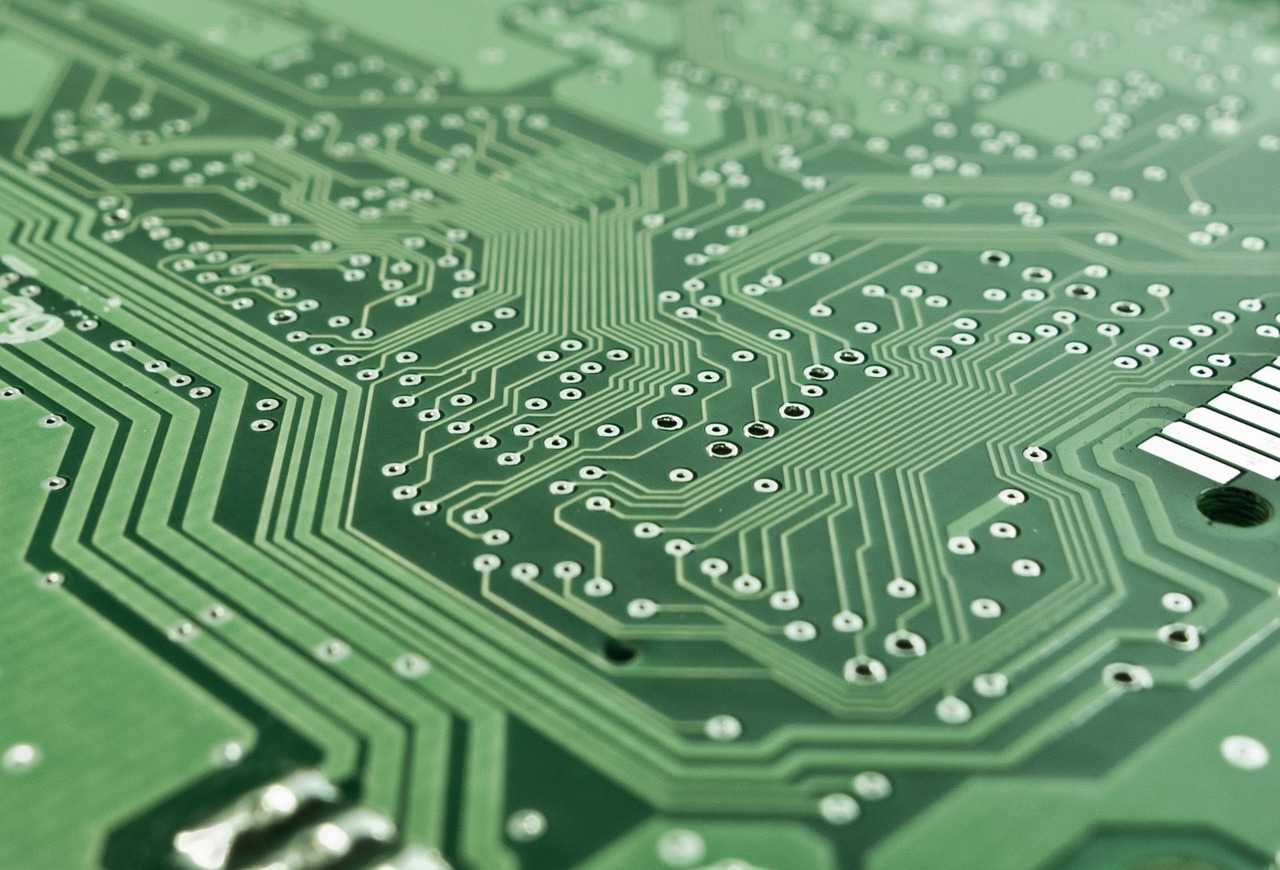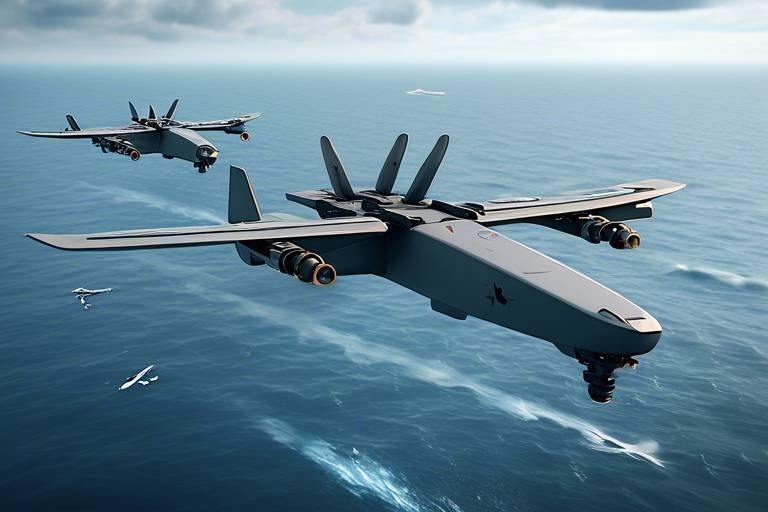The Role of AI in Enhancing Radar Signal Processing
Artificial Intelligence (AI) is not just a buzzword; it’s a game-changer in various fields, and radar signal processing is no exception. Imagine how radar systems, which have been around for decades, are now being turbocharged with AI capabilities. This revolution is not just about making things faster; it’s about enhancing accuracy, efficiency, and overall capabilities. With AI, radar systems can interpret data like never before, leading to groundbreaking advancements in aviation, defense, meteorology, and beyond.
So, what exactly does this mean for radar signal processing? First off, AI enables systems to analyze vast amounts of data at lightning speed. Think of it like having a supercharged brain that can sift through mountains of information to find critical insights. This capability is particularly vital in applications where real-time decision-making is crucial, such as in military operations or air traffic control.
Moreover, the integration of AI into radar systems allows for a level of data interpretation that was previously unimaginable. Traditional methods often struggled with noise and interference, leading to missed detections or false alarms. However, with AI techniques such as machine learning and deep learning, radar systems can now filter out the noise, identify patterns, and make sense of complex environments. This not only improves detection rates but also enhances the reliability of the information being processed.
In addition to improving detection and classification, AI also plays a pivotal role in anomaly detection. Imagine a radar system that can learn from its past experiences and adapt to new situations. This is the power of AI. By continuously learning from incoming data, these systems can identify unusual patterns or behaviors that may indicate a threat, thereby providing a significant advantage in various scenarios.
Furthermore, the benefits of integrating AI with radar systems extend beyond just enhanced performance. The operational efficiency gained through AI means that personnel can focus on more strategic tasks rather than getting bogged down in data analysis. This shift not only saves time but also reduces the likelihood of human error, resulting in safer and more effective operations.
However, the journey toward fully realizing the potential of AI in radar signal processing is not without its challenges. Issues such as data quality, computational demands, and algorithm interpretability must be addressed to harness the full power of these technologies. As we delve deeper into this topic, we will explore the various AI techniques being utilized, the benefits they bring, the challenges they face, and the exciting future that lies ahead for radar signal processing.
- What is radar signal processing? Radar signal processing involves interpreting radar data to detect and track objects. It is essential for applications in aviation, defense, and weather forecasting.
- How does AI enhance radar signal processing? AI enhances radar signal processing by improving data interpretation, enabling real-time analysis, and enhancing target detection and anomaly identification.
- What are the challenges of integrating AI into radar systems? Challenges include ensuring data quality, managing computational demands, and making algorithms interpretable for users.
- What future trends can we expect in AI and radar signal processing? Future trends include greater integration with technologies like IoT and 5G, as well as addressing ethical considerations in AI deployment.

Introduction to Radar Signal Processing
Radar signal processing is an essential component in the interpretation of radar data, which plays a pivotal role across various fields, from aviation and defense to meteorology. At its core, radar technology uses radio waves to detect objects and determine their distance, speed, and direction. The processing of these signals is crucial for transforming raw data into meaningful information that can be acted upon. Imagine trying to find a needle in a haystack; without effective radar signal processing, identifying and tracking targets in a complex environment can feel just as daunting.
The fundamental concepts of radar signal processing involve several key techniques, including signal filtering, data fusion, and signal detection. Each of these techniques contributes to the overall effectiveness of radar systems. For instance, signal filtering helps to eliminate unwanted noise, allowing for clearer detection of objects. Data fusion combines information from multiple sources to create a comprehensive view of the environment, while signal detection focuses on identifying the presence of objects within the radar's range.
Radar systems have a wide variety of applications, each requiring a unique approach to signal processing. In aviation, for example, radar is used to monitor air traffic, ensuring safety and efficiency in crowded skies. In defense, radar systems are crucial for tracking enemy aircraft and missiles, providing real-time data that can influence strategic decisions. Meteorology relies on radar to monitor weather patterns and predict storms, helping to save lives and property. These examples illustrate just how vital radar signal processing is in our daily lives and the broader world.
As we delve deeper into the integration of artificial intelligence with radar signal processing, it becomes increasingly clear that the potential for enhanced accuracy and efficiency is immense. The future of radar systems is not just about detecting objects; it's about interpreting data in ways that were previously unimaginable. By leveraging advanced algorithms and machine learning techniques, radar technology is on the brink of a revolution, paving the way for smarter, more responsive systems.
- What is radar signal processing?
Radar signal processing involves the techniques and methods used to interpret radar data, allowing for the detection and tracking of objects. - Why is radar signal processing important?
It is crucial for applications in various fields such as aviation, defense, and meteorology, as it transforms raw radar data into actionable insights. - How does AI enhance radar signal processing?
AI improves radar signal processing by utilizing machine learning algorithms to enhance detection accuracy, real-time data processing, and overall operational efficiency. - What are the challenges of integrating AI with radar systems?
Challenges include ensuring data quality, managing computational demands, and maintaining algorithm interpretability.

AI Techniques in Radar Signal Processing
Artificial Intelligence (AI) is not just a buzzword; it's a game-changer in radar signal processing. The integration of AI techniques, particularly machine learning and deep learning, is transforming how we interpret and utilize radar data. Imagine having a radar system that can learn from its experiences and improve its accuracy over time. That's the power of AI! These advanced methodologies are enhancing data interpretation, making decision-making processes faster and more reliable.
At the core of AI's impact on radar signal processing are various techniques that allow systems to analyze vast amounts of data quickly and efficiently. For instance, machine learning algorithms can identify patterns within radar signals that might be imperceptible to human operators. This capability is crucial in applications ranging from aviation safety to military defense systems, where precision is paramount. By leveraging historical data, these algorithms can predict and classify objects, leading to improved situational awareness.
Machine learning encompasses a variety of algorithms that enable systems to learn from data patterns. Among these, supervised learning and unsupervised learning are the most prominent. Supervised learning utilizes labeled datasets to train models, enhancing radar signal processing through improved target recognition and anomaly detection. For example, a radar system trained with labeled images of aircraft can more accurately identify and classify new targets in real-time. On the other hand, unsupervised learning techniques are invaluable for discovering hidden patterns in unlabeled data, assisting in clustering and identifying unknown targets.
In the realm of radar signal processing, supervised learning plays a pivotal role. By providing labeled data, these methods can significantly enhance target recognition capabilities. Imagine a radar system that not only detects an object but also classifies it as a drone, bird, or aircraft with high accuracy. This capability is essential in crowded airspaces or complex environments where distinguishing between different types of targets is critical. The effectiveness of supervised learning can be attributed to its ability to learn from past examples, making it a robust tool for radar applications.
Unsupervised learning techniques are equally fascinating, as they allow radar systems to analyze data without prior labeling. By clustering similar data points, these algorithms can uncover hidden patterns that might otherwise go unnoticed. For instance, a radar system might detect an unusual signal pattern that correlates with a previously unknown type of object. This ability to identify new targets is crucial for enhancing the adaptability of radar systems in dynamic environments.
Deep learning, a subset of machine learning, is revolutionizing radar signal processing by utilizing deep neural networks. These networks are designed to mimic the human brain's functioning, allowing them to process and analyze complex data. In radar applications, deep learning can significantly enhance data analysis and interpretation, leading to more accurate predictions and classifications. For example, a deep learning model can analyze video feeds from radar systems to detect moving objects and predict their trajectories, offering invaluable insights for various industries.
In summary, the integration of AI techniques into radar signal processing is not merely an enhancement; it's a transformation. By leveraging machine learning and deep learning, radar systems can achieve unprecedented levels of accuracy and efficiency. As we continue to explore these technologies, the future of radar signal processing looks incredibly promising, paving the way for innovations that could redefine how we approach data interpretation and decision-making.
- What is radar signal processing? Radar signal processing involves interpreting radar data to identify and track objects. It is crucial in various applications, including aviation, defense, and meteorology.
- How does AI improve radar signal processing? AI enhances radar signal processing by enabling systems to learn from data patterns, improving accuracy and efficiency in detecting and classifying targets.
- What are the main AI techniques used in radar signal processing? The main techniques include machine learning, deep learning, supervised learning, and unsupervised learning.
- What challenges does AI face in radar signal processing? Challenges include data quality, computational demands, and the interpretability of AI algorithms.

Machine Learning Algorithms
Machine learning algorithms are at the forefront of transforming radar signal processing, acting like a digital detective that learns from patterns and nuances in the data. Imagine a radar system that not only detects objects but also understands their behavior and characteristics. This is precisely what machine learning brings to the table. By leveraging vast amounts of data, these algorithms can improve detection and classification accuracy, making radar systems smarter and more efficient.
One of the main types of machine learning algorithms used in radar signal processing is supervised learning. This method requires a labeled dataset, which means that the data is pre-categorized. For instance, if we are training a radar system to identify different types of aircraft, we would provide it with numerous examples of labeled data, such as images or signals from various aircraft types. The algorithm learns from these examples and can then classify new, unseen data with impressive accuracy. The benefits of supervised learning in radar systems include:
- Enhanced Target Recognition: The ability to identify specific types of targets based on learned characteristics.
- Improved Anomaly Detection: Quickly spotting unusual patterns that could indicate threats or errors.
On the other hand, we have unsupervised learning, which is like giving the radar system a puzzle without the solution. This approach allows the algorithm to explore the data without predefined labels, discovering hidden patterns and clusters. For instance, if a radar system encounters a new type of signal, unsupervised learning can help categorize it based on similarities to previously encountered signals. This capability is crucial for:
- Clustering Unknown Targets: Grouping similar signals to identify new or unidentified objects.
- Pattern Recognition: Finding trends in data that might not be immediately obvious.
In summary, machine learning algorithms serve as powerful tools in radar signal processing, enhancing the system's ability to interpret complex data and make informed decisions. With the continuous evolution of these algorithms, we can expect even more sophisticated applications in the future, further pushing the boundaries of what radar technology can achieve.
- What are machine learning algorithms? Machine learning algorithms are computational methods that enable systems to learn from data, improving their performance over time without being explicitly programmed.
- How do machine learning algorithms enhance radar signal processing? They improve detection and classification accuracy, allowing radar systems to interpret complex data more effectively and make timely decisions.
- What is the difference between supervised and unsupervised learning? Supervised learning uses labeled data for training, while unsupervised learning identifies patterns in unlabeled data.
- Can machine learning algorithms adapt to new signals? Yes, especially unsupervised learning algorithms, which can discover and categorize new patterns without prior knowledge.

Supervised Learning Approaches
Supervised learning approaches are a fundamental aspect of artificial intelligence that significantly enhance radar signal processing capabilities. By utilizing labeled data for training, these methods allow systems to learn from examples, making them particularly effective in tasks like target recognition and anomaly detection. Imagine teaching a child to identify different types of birds by showing them pictures and naming each one; that's essentially what supervised learning does for radar systems. It helps them understand what to look for in the data they process.
In radar signal processing, supervised learning algorithms can be employed to improve the accuracy of detecting specific targets, such as aircraft or ships, amidst various noise and clutter. For instance, a trained model can distinguish between a commercial airplane and a flock of birds, which is crucial for aviation safety. The algorithms learn from a dataset containing numerous examples, gradually refining their ability to classify and predict outcomes based on new, unseen data.
One popular supervised learning technique in radar applications is Support Vector Machines (SVM). SVMs work by finding the optimal hyperplane that separates different classes in the dataset. This method is particularly effective in high-dimensional spaces, making it suitable for complex radar data. Another notable approach is Random Forests, which uses multiple decision trees to enhance classification accuracy. By aggregating the results from various trees, the model can reduce overfitting and improve reliability in real-world scenarios.
Moreover, the success of supervised learning in radar signal processing can be attributed to several factors:
- High Accuracy: By training on labeled datasets, supervised learning algorithms can achieve high levels of accuracy in target detection and classification.
- Robustness: These algorithms can be designed to withstand noise and variations in data, ensuring reliable performance in diverse environments.
- Scalability: Supervised learning models can be scaled to handle large datasets, making them suitable for modern radar systems that generate vast amounts of information.
However, it’s essential to note that the effectiveness of supervised learning approaches largely depends on the quality and quantity of the training data. If the dataset is biased or insufficient, the model's performance can be compromised. Therefore, ensuring access to high-quality labeled data is critical for the successful application of these methodologies in radar signal processing.
In conclusion, supervised learning approaches play a pivotal role in enhancing radar signal processing by enabling systems to learn from labeled examples. As technology advances and more sophisticated algorithms are developed, we can expect even greater improvements in the accuracy and efficiency of radar systems, paving the way for safer and more reliable operations across various industries.
- What is supervised learning? Supervised learning is a type of machine learning where algorithms learn from labeled training data to make predictions or classifications on new data.
- How does supervised learning improve radar signal processing? It enhances radar signal processing by enabling accurate target recognition and anomaly detection through the analysis of labeled datasets.
- What are some common algorithms used in supervised learning for radar applications? Common algorithms include Support Vector Machines (SVM) and Random Forests, which help improve classification accuracy and robustness.
- Why is data quality important in supervised learning? The effectiveness of supervised learning algorithms heavily relies on the quality and quantity of training data; poor data can lead to inaccurate models.

Unsupervised Learning Techniques
Unsupervised learning techniques are like a treasure hunt in the vast ocean of data, where the goal is to uncover hidden patterns and relationships without any prior guidance. Unlike supervised learning, which relies on labeled datasets to train algorithms, unsupervised learning dives into the uncharted waters of unlabeled data. This approach is particularly valuable in radar signal processing, where the complexities and variabilities of signals can obscure critical information.
One of the primary methods used in unsupervised learning is clustering. By grouping similar data points together, clustering algorithms help identify structures within the data. For instance, in radar signal processing, clustering can be utilized to categorize different types of targets based on their signal characteristics. This allows for the identification of unknown objects that may not have been previously classified, enhancing situational awareness and operational effectiveness.
Another significant technique is dimensionality reduction. This method simplifies complex datasets by reducing the number of variables, making it easier to visualize and analyze the data. Techniques such as Principal Component Analysis (PCA) and t-Distributed Stochastic Neighbor Embedding (t-SNE) are commonly employed to distill radar data into more manageable forms while retaining essential information. By doing so, analysts can gain insights and make informed decisions more quickly.
The applications of unsupervised learning in radar signal processing extend beyond mere detection and classification. For example, anomaly detection is a critical area where these techniques shine. By establishing a baseline of normal behavior within the radar data, unsupervised learning can flag any deviations from this norm as potential anomalies. This capability is invaluable in various fields, including defense, where identifying unexpected objects or behaviors can mean the difference between safety and danger.
Despite its advantages, unsupervised learning is not without challenges. One major hurdle is the interpretation of the results. Since there are no predefined labels to guide the analysis, understanding the significance of the clusters or patterns discovered can be tricky. Analysts must rely on their expertise and contextual knowledge to draw meaningful conclusions from the data.
In summary, unsupervised learning techniques play a pivotal role in enhancing radar signal processing. By enabling the discovery of hidden patterns, improving target identification, and facilitating anomaly detection, these methods empower organizations to make smarter, data-driven decisions. As technology continues to evolve, the integration of unsupervised learning into radar systems promises to unlock even greater capabilities, paving the way for a more efficient and effective approach to signal processing.
- What is unsupervised learning? Unsupervised learning is a type of machine learning that analyzes and clusters unlabeled data to discover hidden patterns without prior guidance.
- How does clustering work in radar signal processing? Clustering groups similar radar signals, allowing for the identification of different types of targets based on their characteristics.
- What are the challenges of unsupervised learning? The main challenges include interpreting results without predefined labels and ensuring the quality of input data.
- Can unsupervised learning detect anomalies? Yes, unsupervised learning can identify anomalies by comparing current data against established norms.

Deep Learning Applications
Deep learning has emerged as a transformative force in the realm of radar signal processing, revolutionizing how we analyze and interpret radar data. By leveraging the power of neural networks, deep learning algorithms can process vast amounts of data with remarkable efficiency, uncovering patterns that traditional methods may overlook. Imagine a radar system that not only detects objects but also understands their characteristics and behaviors—this is the promise of deep learning.
One of the most exciting applications of deep learning in radar signal processing is in object detection and classification. Using convolutional neural networks (CNNs), these systems can be trained on labeled datasets to recognize various targets, from aircraft to drones, with high accuracy. The capability to differentiate between similar objects, such as distinguishing a bird from a small drone, is a game-changer in fields like aviation safety and military surveillance.
Moreover, deep learning enhances anomaly detection in radar signals. Traditional methods might struggle to identify unusual patterns or unexpected behaviors, but deep learning excels in this area. By training models on historical data, these systems can learn what "normal" looks like and flag any deviations, which could indicate potential threats or system malfunctions. This ability is particularly crucial in defense applications where identifying an intruder or an unusual radar signature can be a matter of national security.
Another significant application is in clutter suppression. Radar systems often face challenges from environmental noise and clutter, which can obscure valuable signals. Deep learning algorithms can be trained to recognize and filter out these unwanted signals, allowing for clearer data interpretation. This is akin to having a noise-canceling headset that allows you to focus on a specific sound amidst a cacophony of background noise.
Additionally, the integration of deep learning with radar technology facilitates real-time data processing. This is vital in scenarios such as autonomous vehicles, where immediate analysis of radar data can inform navigation decisions. For instance, deep learning models can quickly assess the surrounding environment, identifying obstacles and making split-second decisions to enhance safety and efficiency.
To illustrate the impact of deep learning in radar signal processing, consider the following table that summarizes key applications and their benefits:
| Application | Description | Benefits |
|---|---|---|
| Object Detection | Identifying and classifying various targets using CNNs. | Improved accuracy and reliability in target recognition. |
| Anomaly Detection | Detecting unusual patterns in radar signals. | Enhanced security and threat identification. |
| Clutter Suppression | Filtering out environmental noise and clutter. | Clearer signal interpretation and data accuracy. |
| Real-time Processing | Immediate analysis for autonomous systems. | Faster decision-making and improved safety. |
In conclusion, deep learning applications in radar signal processing are not just enhancing existing capabilities; they are paving the way for new possibilities. As technology continues to advance, we can expect even more innovative applications that will redefine how we utilize radar systems across various industries.
- What is deep learning in radar signal processing?
Deep learning refers to the use of neural networks to analyze and interpret radar data, significantly enhancing detection, classification, and anomaly detection capabilities. - How does deep learning improve object detection?
Deep learning improves object detection by training models on large datasets, allowing them to recognize and differentiate between various targets with high accuracy. - Can deep learning help in real-time radar data analysis?
Yes, deep learning algorithms are capable of processing radar data in real-time, enabling quicker decision-making in critical applications such as autonomous vehicles and military operations. - What are the challenges of implementing deep learning in radar systems?
Challenges include the need for high-quality training data, computational demands, and ensuring the interpretability of the algorithms used.

Benefits of Integrating AI with Radar Systems
Integrating artificial intelligence (AI) with radar systems is not just a trend; it's a transformative leap that brings a myriad of benefits to various industries. Imagine the ability to process vast amounts of radar data in real-time, making decisions faster than ever before. This is not science fiction; it's the reality that AI is helping to create. The fusion of AI technologies with radar systems enhances accuracy, efficiency, and operational capabilities, leading to significant advancements in fields such as aviation, defense, and meteorology.
One of the most compelling advantages of AI integration is the improved accuracy of radar data interpretation. Traditional radar systems often struggle with noise and interference, which can lead to false alarms or missed detections. However, AI algorithms are designed to learn from data patterns and can effectively filter out noise, ensuring that only relevant signals are processed. This leads to a more reliable detection of targets, enhancing safety and operational effectiveness.
Moreover, the real-time processing capabilities of AI allow radar systems to analyze data almost instantaneously. This is particularly crucial in scenarios where time is of the essence, such as in military operations or during severe weather events. With AI, operators can receive immediate insights, enabling quicker decision-making. For instance, in an aviation context, AI can assist in identifying potential hazards on the runway, allowing for timely interventions that could prevent accidents.
Another significant benefit is the enhancement of operational efficiency. By automating routine tasks and data analysis, AI frees up human operators to focus on more complex decision-making processes. This not only improves productivity but also reduces the likelihood of human error, which can be critical in high-stakes environments. For example, in defense applications, AI can continuously monitor radar feeds, alerting personnel only when an anomaly is detected, thus streamlining operations.
Furthermore, AI integration allows for adaptive learning. As radar systems collect more data over time, AI algorithms can refine their models, improving their predictive capabilities. This means that the more the system is used, the better it becomes at recognizing patterns and anomalies. This continuous improvement cycle is vital for maintaining a competitive edge in fields where technology is constantly evolving.
To illustrate the benefits more clearly, let’s take a look at a comparative table showcasing traditional radar systems versus AI-enhanced radar systems:
| Feature | Traditional Radar Systems | AI-Enhanced Radar Systems |
|---|---|---|
| Data Processing Speed | Moderate | High |
| Accuracy | Prone to Errors | High Precision |
| Adaptability | Static | Dynamic Learning |
| Operational Efficiency | Manual Oversight Required | Automated Monitoring |
In summary, the integration of AI with radar systems not only enhances the accuracy and efficiency of data processing but also opens up new avenues for operational capabilities. As industries continue to embrace this technology, we can expect even greater advancements that will redefine how radar systems are utilized in various applications.
- What industries benefit the most from AI-enhanced radar systems? Industries such as aviation, defense, and meteorology are leading the way in utilizing AI for radar signal processing.
- How does AI improve the accuracy of radar systems? AI algorithms filter out noise and learn from data patterns, which helps in reducing false detections and improving target recognition.
- Can AI radar systems operate in real-time? Yes, AI enhances the real-time processing capabilities of radar systems, allowing for faster decision-making.
- What challenges come with integrating AI into radar systems? Challenges include data quality, computational demands, and the need for interpretability of AI algorithms.

Real-time Data Processing
In today's fast-paced world, the ability to process radar data in real-time is not just a luxury but a necessity. Imagine a scenario where a military operation depends on the swift identification of incoming threats. In such cases, can mean the difference between success and failure. By integrating artificial intelligence into radar systems, we can achieve unprecedented speeds in data analysis, allowing operators to make informed decisions almost instantaneously.
AI algorithms enhance the speed of radar signal processing by automating the interpretation of complex data patterns. These algorithms analyze incoming signals, filter out noise, and highlight critical information within milliseconds. For instance, when a radar system detects multiple objects, AI can quickly categorize these objects based on their movement patterns, shapes, and sizes. This rapid classification is essential, especially in environments where every second counts, such as in air traffic control or defense operations.
Moreover, the integration of AI facilitates a more dynamic response to changing conditions. Traditional radar systems often struggled with adapting to new data inputs, leading to delays in response time. However, with the use of machine learning techniques, radar systems can continuously learn and adapt from incoming data streams. This means that as new patterns emerge, the system becomes better at recognizing and responding to them. The result? Enhanced situational awareness and improved decision-making capabilities.
To illustrate the impact of real-time data processing, consider the following table that compares traditional radar processing times with AI-enhanced systems:
| Processing Method | Average Processing Time | Accuracy Rate |
|---|---|---|
| Traditional Radar Processing | 1-3 seconds | 75% - 85% |
| AI-Enhanced Radar Processing | Milliseconds | 90% - 98% |
As shown in the table, the integration of AI significantly reduces processing time while simultaneously increasing accuracy. This leap in performance is particularly beneficial in complex environments where multiple targets are present. With AI, radar systems can not only detect these targets faster but can also track their movements more reliably.
In conclusion, the evolution of radar signal processing through AI is paving the way for a future where real-time data analysis becomes standard practice. This capability not only enhances operational efficiency but also contributes to greater safety and effectiveness in various applications, from aviation to military operations. As we continue to refine these technologies, we can expect even more remarkable advancements that will redefine what is possible in radar signal processing.
- What is real-time data processing in radar systems?
Real-time data processing refers to the ability of radar systems to analyze incoming data and produce actionable insights almost instantaneously, allowing for quick decision-making.
- How does AI improve radar signal processing?
AI enhances radar signal processing by automating data interpretation, improving accuracy, and enabling systems to adapt to new patterns in real-time.
- What are the applications of real-time radar processing?
Real-time radar processing is crucial in various fields, including aviation for air traffic control, defense for military operations, and meteorology for tracking weather patterns.

Improved Target Detection
In the realm of radar signal processing, stands out as one of the most significant advancements brought about by the integration of artificial intelligence (AI). Traditional radar systems, while effective, often struggle with identifying and tracking multiple targets, especially in complex environments filled with noise and interference. However, AI algorithms have revolutionized this aspect, enabling systems to discern subtle patterns and make accurate predictions that were previously unattainable.
Imagine you're at a busy airport, where multiple aircraft are taking off and landing simultaneously. In such scenarios, the ability to detect and track each aircraft without confusion is critical. AI enhances radar systems by employing advanced algorithms that analyze incoming data in real-time, allowing for the accurate identification of targets amidst the chaos. This capability is particularly beneficial in applications such as aviation safety, military operations, and traffic management.
One of the primary ways AI improves target detection is through machine learning. By training algorithms on vast datasets containing various target signatures, these systems learn to recognize the unique characteristics of different objects. For instance:
- Aircraft: AI can distinguish between commercial airliners and military jets based on their radar profiles.
- Weather Phenomena: It can differentiate between rain, snow, and hail, which is crucial for meteorological applications.
- Unmanned Aerial Vehicles (UAVs): AI can identify drones, which may have different signatures compared to traditional aircraft.
Moreover, deep learning techniques, a subset of machine learning, have proven particularly effective in enhancing target detection. By utilizing neural networks, these systems can process and analyze large volumes of radar data, identifying complex patterns that might elude simpler algorithms. This capability allows for improved detection rates and reduced false positives, which is vital for maintaining operational efficiency and safety.
However, the journey towards improved target detection is not without its challenges. The effectiveness of AI algorithms heavily relies on the quality and diversity of the training data. If the dataset lacks representation of certain target types or is plagued by noise, the AI's performance can be compromised. Therefore, ongoing efforts are needed to ensure that datasets are comprehensive and reflective of real-world scenarios.
In conclusion, the integration of AI into radar signal processing has significantly enhanced target detection capabilities. By leveraging advanced algorithms and deep learning techniques, radar systems can now provide more accurate, reliable, and timely information, which is crucial for decision-making across various industries. As technology continues to evolve, we can expect even greater improvements in this area, paving the way for safer skies and more efficient operations.
- What is radar signal processing?
Radar signal processing involves interpreting radar data to detect, track, and identify objects in the environment. - How does AI improve radar systems?
AI enhances radar systems by enabling real-time data analysis, improving target detection accuracy, and reducing false positives. - What are the challenges of integrating AI into radar systems?
Challenges include data quality, computational demands, and the need for robust training datasets. - What industries benefit from improved target detection?
Industries such as aviation, defense, meteorology, and traffic management benefit significantly from enhanced target detection capabilities.

Challenges in AI-Enhanced Radar Signal Processing
While the integration of artificial intelligence into radar signal processing presents exciting opportunities, it also brings forth a set of significant challenges that must be addressed. One of the most pressing issues is data quality and availability. The effectiveness of AI algorithms is heavily reliant on the quality of the input data they receive. Radar systems often operate in diverse environments where data can be noisy or incomplete. This noise can stem from various sources, including environmental factors, interference from other signals, and limitations in the radar hardware itself. Consequently, ensuring high-quality datasets becomes paramount for training effective AI models. Without clean and comprehensive data, the algorithms may struggle to learn accurately, leading to suboptimal performance in real-world applications.
Another critical challenge is the computational demands associated with AI algorithms. Many AI techniques, especially deep learning methods, require substantial computational resources to process large volumes of radar data effectively. This can pose a problem, particularly in scenarios where real-time processing is essential. The need for high-performance computing systems can increase costs and complicate the deployment of AI-enhanced radar systems in the field. Moreover, optimizing these algorithms for efficiency without sacrificing accuracy is a delicate balancing act that researchers and engineers must navigate.
Additionally, there is the issue of algorithm interpretability. As AI systems become more complex, understanding how these algorithms make decisions can become increasingly challenging. This lack of transparency can be problematic, especially in critical applications such as defense and aviation, where understanding the rationale behind a decision is crucial for trust and accountability. Stakeholders need to ensure that AI systems are not only accurate but also interpretable, allowing operators to grasp how decisions are made and to verify their validity.
In summary, while AI has the potential to revolutionize radar signal processing, addressing these challenges is essential for successful implementation. The interplay between data quality, computational demands, and algorithm interpretability will determine the effectiveness of AI in enhancing radar systems. As the field evolves, ongoing research and development will be vital in overcoming these hurdles and unlocking the full potential of AI in radar applications.
- What are the main challenges of integrating AI into radar systems?
The primary challenges include data quality and availability, computational demands, and algorithm interpretability. - How does data quality affect AI performance in radar signal processing?
Poor data quality can lead to inaccurate model training, resulting in suboptimal performance when the system is deployed in real-world scenarios. - Why are computational demands a concern for AI in radar systems?
Many AI algorithms are computationally intensive, requiring significant resources, especially for real-time processing, which can complicate deployment. - What is algorithm interpretability, and why is it important?
Algorithm interpretability refers to the ability to understand how AI models make decisions. It is crucial in high-stakes applications where trust and accountability are paramount.

Data Quality and Availability
In the world of radar signal processing, the phrase “garbage in, garbage out” holds especially true. The performance of artificial intelligence algorithms is heavily reliant on the quality of the input data they are fed. If the data is noisy or incomplete, the results can be misleading or entirely inaccurate. This situation can lead to poor decision-making, especially in critical applications like aviation and defense, where precision is paramount. Therefore, ensuring high-quality data is not just important; it’s absolutely essential.
Moreover, the availability of quality data poses another significant challenge. In many cases, acquiring sufficient labeled data for training AI models can be a daunting task. For instance, in military applications, the data may be classified or restricted, limiting access for research and development. Similarly, in meteorological applications, the data can be sparse, especially in remote areas where radar coverage is limited. This scarcity can hinder the development of robust AI models that are capable of making accurate predictions.
To combat these challenges, several strategies can be employed:
- Data Augmentation: This technique involves artificially increasing the size of the training dataset by creating modified versions of existing data. For example, flipping, rotating, or adding noise to radar signals can help in generating more training samples.
- Collaboration: Partnerships between organizations can facilitate data sharing, allowing access to diverse datasets that can improve the robustness of AI models.
- Utilizing Synthetic Data: In some cases, generating synthetic data using simulations can provide a viable alternative when real-world data is scarce. This approach can be particularly useful in training AI systems for specific scenarios.
In summary, the quality and availability of data play a crucial role in the effectiveness of AI-enhanced radar signal processing. Without high-quality data, even the most sophisticated algorithms can fall short of expectations. As the field continues to evolve, addressing these data-related challenges will be key to unlocking the full potential of AI in radar applications.
- What is the importance of data quality in radar signal processing?
Data quality is critical because it directly affects the accuracy and reliability of AI algorithms. Poor quality data can lead to incorrect interpretations and decisions. - How can organizations improve data availability?
Organizations can improve data availability through collaboration, data sharing agreements, and by leveraging synthetic data generation techniques. - What are some common issues related to radar data acquisition?
Common issues include noise interference, incomplete datasets, and limitations in radar coverage, especially in remote areas.

Computational Demands
The integration of artificial intelligence (AI) into radar signal processing has undoubtedly opened up a world of possibilities, but it hasn't come without its challenges. One of the most significant hurdles that developers and engineers face is the that these advanced algorithms impose. As radar systems become more sophisticated, the volume and complexity of data they generate also increase exponentially. This surge in data necessitates powerful computational resources to ensure timely and accurate processing.
To put it into perspective, think of a radar system as a busy highway during rush hour. Just as traffic can become congested with too many vehicles, radar systems can become overwhelmed by the sheer amount of data they need to process. The algorithms employed, particularly those based on deep learning, require substantial computational power to analyze vast datasets effectively. This is especially true when we consider real-time applications, where delays can lead to critical failures in decision-making processes.
The computational requirements can be categorized into several key areas:
- Data Processing Speed: AI algorithms must process incoming radar signals in real-time to provide actionable insights. This requires high-speed processors and optimized software to handle the data flow without lag.
- Memory Usage: Complex models often demand significant memory resources. The larger the dataset and the more intricate the model, the more memory is required to store and manipulate data efficiently.
- Energy Consumption: The computational power needed for AI can lead to increased energy consumption, which is a concern for mobile and remote radar systems that rely on battery power.
Moreover, the choice of hardware plays a crucial role in addressing these computational demands. High-performance computing (HPC) systems, graphical processing units (GPUs), and field-programmable gate arrays (FPGAs) are often employed to mitigate these challenges. These technologies can significantly accelerate the processing capabilities of radar systems, enabling them to analyze complex scenarios in real-time.
However, it's not just about having the right hardware. Algorithm optimization is equally vital. Developers are continually working on refining algorithms to reduce their computational load while maintaining or even improving accuracy. Techniques such as model pruning, where less critical parts of a model are removed, and quantization, which reduces the precision of calculations, are becoming more prevalent in the field.
In conclusion, while the computational demands of integrating AI into radar signal processing present significant challenges, they also drive innovation in hardware and software solutions. As technology continues to advance, we can expect to see even more efficient methods for processing radar data, paving the way for enhanced capabilities in various applications, from defense to meteorology.
- What are the main computational challenges in AI radar signal processing? The main challenges include data processing speed, memory usage, and energy consumption, all of which can impact the effectiveness of radar systems.
- How does hardware impact the performance of AI in radar systems? High-performance computing systems, GPUs, and FPGAs can significantly enhance processing capabilities, enabling real-time data analysis and improving overall system performance.
- What techniques are used to optimize AI algorithms for radar signal processing? Techniques such as model pruning and quantization are commonly used to reduce the computational load of AI algorithms while maintaining accuracy.

Future Trends in AI and Radar Signal Processing
The future of AI in radar signal processing is not just bright; it's positively dazzling! As technology evolves at breakneck speed, we find ourselves on the cusp of revolutionary changes that promise to redefine how radar systems operate. Imagine a world where radar systems not only detect objects but also predict their movements with uncanny accuracy. This is not science fiction; this is the future we are stepping into!
One of the most exciting trends is the integration of AI with other cutting-edge technologies. For instance, the convergence of AI with the Internet of Things (IoT) and 5G networks is set to enhance radar capabilities tremendously. With IoT, radar systems can gather data from a plethora of connected devices, creating a more comprehensive understanding of the environment. Meanwhile, 5G's ultra-fast data transfer speeds allow for real-time processing and analysis of radar data, enabling quicker responses to potential threats or changes in the environment.
Moreover, as we delve deeper into the realm of machine learning and deep learning, we can anticipate a surge in the capabilities of radar systems to perform real-time anomaly detection. Imagine a radar system that can not only spot a moving object but also analyze its behavior and predict its next move. This would be a game-changer in applications ranging from defense to aviation and beyond.
Another trend that cannot be overlooked is the growing emphasis on ethical considerations in AI development. As radar systems become more autonomous, the need for responsible AI practices becomes paramount. Developers and researchers will need to address potential biases in data, ensure transparency in AI decision-making processes, and prioritize user privacy. The future of radar signal processing will not just be about technological advancements; it will also require a commitment to ethical standards that safeguard users and society as a whole.
As we look ahead, the potential for collaborative AI is also on the rise. This concept involves multiple AI systems working together to enhance radar signal processing. Such collaboration can lead to improved data fusion techniques, where information from various radar sources is combined to create a more accurate picture of the environment. This could be particularly beneficial in complex scenarios, such as urban environments or crowded airspaces, where multiple objects are being tracked simultaneously.
In conclusion, the future trends in AI and radar signal processing are not just about technological advancements; they are about creating a smarter, more efficient, and ethical approach to radar systems. As we embrace these changes, we pave the way for innovations that will enhance safety, security, and situational awareness in our increasingly complex world.
- What is the role of AI in radar signal processing?
AI enhances radar signal processing by improving data interpretation, target detection, and real-time decision-making capabilities.
- How does AI improve accuracy in radar systems?
By utilizing machine learning and deep learning algorithms, AI can analyze vast amounts of data to identify patterns and anomalies, leading to more accurate results.
- What are the challenges of integrating AI with radar technology?
Key challenges include ensuring data quality, managing computational demands, and addressing ethical considerations in AI development.
- What future trends should we expect in AI and radar signal processing?
Expect increased integration with IoT and 5G, advancements in real-time anomaly detection, and a greater focus on ethical AI practices.

Integration with Other Technologies
The integration of Artificial Intelligence (AI) with other cutting-edge technologies is reshaping the landscape of radar signal processing. As we delve into this exciting intersection, we find that advancements in the Internet of Things (IoT) and 5G connectivity are significantly enhancing the capabilities and applications of radar systems. Imagine a world where radar systems can communicate seamlessly with a network of smart devices, sharing real-time data and insights to create a more comprehensive understanding of the environment.
One of the most compelling aspects of this integration is the ability to leverage vast amounts of data collected from various sources. For instance, IoT devices can provide additional context to radar data, such as environmental conditions or the status of nearby objects. This fusion of data not only improves the accuracy of radar interpretations but also enables predictive analytics, where systems can forecast potential scenarios based on historical and real-time data.
Moreover, the high-speed capabilities of 5G networks facilitate the rapid transmission of radar data from multiple sources, allowing for enhanced situational awareness. This is particularly crucial in applications such as autonomous vehicles and smart cities, where timely data processing can mean the difference between safety and disaster. By combining AI with these technologies, we create a robust framework that supports complex decision-making processes in real-time.
To illustrate the benefits of this integration, consider the following table that highlights key advantages:
| Technology | Key Advantages |
|---|---|
| AI | Enhanced data analysis, improved detection accuracy, and predictive capabilities. |
| IoT | Real-time data collection from various sources, environmental context, and improved situational awareness. |
| 5G | Faster data transmission, reduced latency, and the ability to handle more connected devices. |
Furthermore, the synergy between these technologies can lead to innovative applications across various sectors, including defense, aviation, and smart transportation. For example, in defense, radar systems integrated with AI and IoT can monitor airspace more effectively, identifying potential threats in real-time while adapting to changing conditions. Similarly, in smart transportation, the integration of radar with AI can enhance traffic management systems, improving safety and efficiency on the roads.
However, as we embrace these advancements, it is crucial to address the challenges that come with them. Issues such as data privacy, security, and the ethical implications of AI must be carefully considered to ensure that these technologies are used responsibly. The path forward involves not only harnessing the power of AI and other technologies but also fostering a culture of ethical responsibility and transparency in their deployment.
- What is the role of AI in radar signal processing?
AI enhances radar signal processing by improving data interpretation, increasing detection accuracy, and enabling real-time decision-making. - How does IoT contribute to radar systems?
IoT devices provide additional data and context, which, when integrated with radar systems, lead to better analysis and situational awareness. - What are the benefits of using 5G technology with radar?
5G technology allows for faster data transmission, which is essential for real-time processing and analysis in radar applications. - What ethical considerations should be taken into account?
Data privacy, security, and the responsible use of AI are critical ethical considerations that must be addressed when integrating AI with radar systems.

Ethical Considerations
As artificial intelligence (AI) continues to weave its way into the fabric of radar signal processing, it's essential to pause and reflect on the that accompany this technological evolution. The integration of AI into radar systems can bring about tremendous benefits, but it also raises significant ethical questions that must be addressed. For instance, how do we ensure that these systems are used responsibly and do not infringe on individual privacy? The potential for misuse of radar data is a pressing concern that cannot be overlooked.
Moreover, the issue of algorithmic bias is another critical factor to consider. AI systems learn from data, and if the input data is skewed or unrepresentative, the outcomes can lead to biased decision-making. This could result in certain groups being unfairly targeted or misidentified, which raises questions about fairness and accountability. Therefore, it is imperative to establish robust frameworks for monitoring and evaluating the performance of AI algorithms in radar applications.
Additionally, the transparency of AI systems is crucial. Users and stakeholders must understand how decisions are made, especially in high-stakes environments like defense and public safety. This calls for clear documentation of the algorithms used, the data sources they rely on, and the rationale behind their outputs. Without transparency, trust in these technologies can erode, leading to skepticism and resistance from the public.
Furthermore, the impact on employment cannot be ignored. As AI becomes more proficient at processing radar signals, there is a legitimate concern about job displacement in sectors that rely on traditional radar operations. While AI can enhance efficiency and accuracy, it is vital to consider how we can reskill and upskill the workforce to adapt to new roles that emerge in this evolving landscape.
In conclusion, while the integration of AI into radar signal processing holds great promise, it is accompanied by a set of ethical considerations that must be proactively addressed. By fostering a culture of responsibility, transparency, and fairness, we can harness the full potential of AI while minimizing its risks. As we move forward, it is essential to engage in ongoing dialogue among technologists, ethicists, and policymakers to ensure that the deployment of AI in radar systems aligns with our societal values and ethical standards.
- What are the main ethical concerns regarding AI in radar signal processing?
The primary concerns include privacy infringement, algorithmic bias, transparency, and the potential impact on employment. - How can we ensure that AI systems are used responsibly?
Establishing robust frameworks for monitoring, evaluating algorithms, and engaging in public dialogue can help ensure responsible use. - What is algorithmic bias, and why is it important?
Algorithmic bias occurs when AI systems make unfair decisions due to skewed input data. It is crucial to address this to promote fairness and accountability. - How does transparency affect trust in AI systems?
Transparency helps users understand how decisions are made, fostering trust and acceptance of AI technologies. - Will AI lead to job losses in radar-related fields?
While AI may enhance efficiency, it could also lead to job displacement. Reskilling and upskilling the workforce will be essential to adapt to new roles.
Frequently Asked Questions
- What is radar signal processing?
Radar signal processing involves interpreting radar data to extract useful information. It plays a crucial role in various applications like aviation, defense, and meteorology by analyzing the signals received from radar systems.
- How does AI enhance radar signal processing?
AI enhances radar signal processing through advanced techniques like machine learning and deep learning. These technologies improve data interpretation, enable real-time processing, and enhance target detection, leading to more accurate and efficient radar systems.
- What are some AI techniques used in radar signal processing?
Common AI techniques include machine learning algorithms, such as supervised and unsupervised learning, as well as deep learning methods. These techniques help in recognizing patterns, classifying targets, and improving overall radar data analysis.
- What are the benefits of integrating AI with radar systems?
Integrating AI with radar systems offers numerous benefits, including improved accuracy, real-time data processing capabilities, and enhanced operational efficiency. This integration allows for quicker decision-making and better situational awareness in critical applications.
- What challenges are associated with AI-enhanced radar signal processing?
Challenges include data quality and availability, as AI algorithms rely heavily on high-quality input data. Additionally, the computational demands of AI can be significant, requiring optimization for real-time applications.
- What are the future trends in AI and radar signal processing?
The future of AI in radar signal processing looks promising, with trends such as integration with IoT and 5G technologies. These advancements are expected to enhance radar capabilities and open up new applications across various sectors.
- Are there ethical considerations in AI radar systems?
Yes, as AI becomes more prevalent in radar systems, ethical considerations arise. It’s important to address issues such as algorithm transparency, bias, and the implications of automated decision-making to ensure responsible use of AI technologies.



















